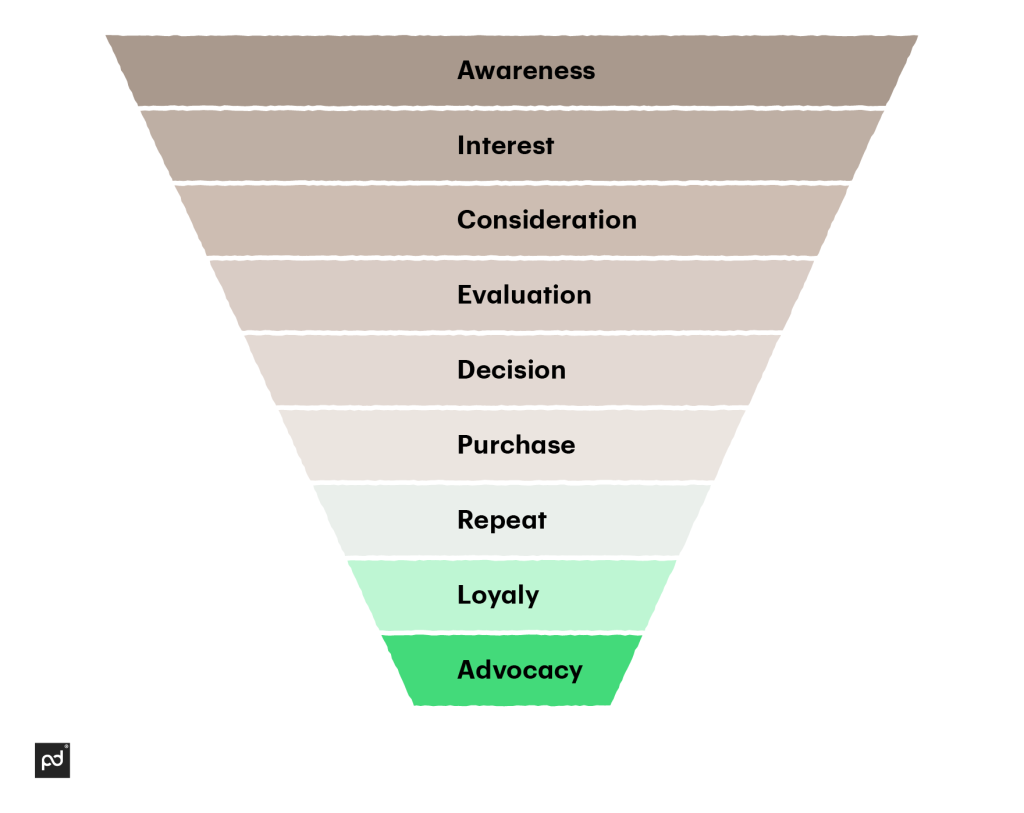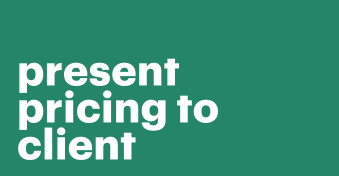Are you sure you’re using different sales and marketing terms properly? (Of course, you are!) But here a place for doubt exists.
For example, when you’re speaking about your sales process and its steps with your sales team, which term do you use: “Sales pipeline”, or “Sales funnel”?
Did you begin to feel uncertainty just now? Let us help you dispel these doubts with our clear research on the topic.
In the article below, you’ll discover unambiguous definitions of both terms — their goals and benefits, as well as the main stages of both the sales funnel and the sales pipeline.
The short answer to the difference between a sales pipeline and a sales funnel
Both of these terms are broadly used in different CRM systems like Salesforce, Monday.com, or Pipedrive.
They describe similar processes, offering visual representations of buyers’ journeys, but from very different points of view.
Both terms are about the stages your consumer (or prospect, or lead) goes through when transitioning to the status of an existing customer.
The sales pipeline
The sales pipeline is focused on your actions at these stages. It illustrates the journey of your prospect, with a final destination being the moment that prospect becomes your customer.
The name describes it clearly; that’s why we used pipes in our picture below.

The sales funnel
The sales funnel’s main metrics are conversions among these stages — they represent the rates of prospects who moved to each successive stage.
The name is quite illustrative here, too, though we’ve slightly modified a conventional vision of the funnel to make it closer to our “IRL” situation.

What is a sales pipeline?
As mentioned, the pipeline operates with the stages your prospect goes through. Based on this fact, we can form our definition, clear and understandable:
The sales pipeline is the journey of a prospect on their way to becoming an existing customer in the form of a sequence of certain steps determined in advance. Once one step is finished, the prospect moves to the next one.
Sales pipeline stages
While every business’ sales pipeline is unique, typical stages of the process exist. Below you can find each stage of the pipeline with a short description.
1. Lead generation (or prospecting)
Each sales activity starts with the generation of leads. If we speak about B2B sales, the first stage is called “prospecting.”
This stage is highly important: here, you can either generate leads or just attract people or businesses who then won’t convert into leads.
That’s why this stage includes a thorough analysis of who your potential customers are, and how you can distinguish them from all the others.
2. Lead qualifying
This stage is about shortlisting your previously gathered group to form a new list of qualified leads.
By doing this, your sales reps determine if those shortlisted have a real need for your product or service, as well as whether they have enough discretionary budget to pay for it.
Knowing your prospects better helps understand their goals and decide whether or not to move forward with them.
One more important thing: Your qualified prospects must be decision-makers in the companies they work for. (Otherwise, all your effort will likely be null and void — a phrase you never want to hear.)
3. Sales meeting (or sales call)
The next step is a session of direct communication between your sales rep and a qualified lead. In previous years, the majority of meetings were run either in person or via telephone calls.
Currently, there are plenty of tools that make remote meeting arrangements a piece of cake — using Zoom, Slack, or any other online method.
This initial meeting aims to present both your company and what you’re offering, discuss the prospect’s needs in-depth, and then modify your offer accordingly following any newly-minted facts.
4. Proposal sending
If the previous stage is completed successfully, it’s time to use your refined data to polish the offer. Use that data to match your prospect’s needs with the features of a product or service you’re offering.
Remember, the better the fit, the better the chances are for successful deal closure. The best way to succeed at this stage is by using special proposal management software.
This helps you quickly craft the most relevant offer using ready-made templates and actual data, and then track your documents to understand the behavior of the second party better.
5. Deal closure
This stage has two possible outcomes. The first is the desired one: your prospect is satisfied enough to become your customer and you both close the deal.
The second is its opposite: your prospect rejected your offer and stopped negotiating with you.
For the deal closing, your agreement with the second party must be signed. Today, the best option in most cases is to sign it electronically.
6. Retention
The most satisfied customers often turn into your most loyal advocates.
This means not only will they return to you when there’s a new need for your product or service — they’ll influence others to do the same.
Such advocates help you sell by persuading their contacts that your product or service is surely worth it. The best thing here is that their effort is absolutely sincere — and free.
Goals and benefits of a sales pipeline
The main goal of the sales pipeline is to streamline your sales processes to increase your revenue within the sales cycle.
Using the sales pipeline may be highly beneficial for your business. Below are the main advantages your business will get by implementing the sales pipeline into your marketing processes.
More transparency and efficiency
Generally, the pipeline is a kind of model of your sales processes.
Once the pipeline is ready, you can easily understand which stage your prospect currently occupies, analyze the issues they’re facing at specific stages, and form guidelines on how to achieve “transport” through subsequent stages with the best possible efficiency.
In other words, you can always see the big picture and make decisions helping your sales become more efficient.
Better resources allocation
Knowing where your prospect is in the pipeline helps with better distribution of your marketing resources.
For example, if your target prospect is currently at the consideration stage, it’s better to prepare and show them more technical and specialized content.
Faster deal closure
This is one of the most attractive benefits tied to using the sales pipeline.
Once you understand your sales activities better and look at them from different angles, it’s easier to understand the obstacles that are slowing down deal closure.
Easier progress tracking
The pipeline helps track the activity of each sales team member separately. Knowing the initial goals and tasks assigned, you can clarify who works with a “full steam ahead” approach — and who doesn’t.
Diving further into efficient usage of the sales pipeline is beyond our scope today. But you can read more about how to tweak your pipeline to gain more in our article How to use a sales pipeline to boost revenue.
What is a sales funnel?
While the pipeline is focused on the stages your prospect travels through to become your customer, the funnel is based on the conversion values between the neighboring stages.
The sales funnel is a model illustrating the whole customer journey — from the first engagement with a brand to becoming a brand advocate — all through the prism of conversion rates between the stages.
In other words, the sales funnel shows how the number of leads drops from stage to stage of the funnel.
Stages of a sales funnel
The stages of the sales funnel are fairly different from the ones in the pipeline. And the set of stages can vary case by case as well.
The simplest model of the sales funnel includes three main stages: awareness, consideration, and decision.
Here, we’re presenting you with a more sophisticated and accurate model. Below you can find a full list of possible stages, with short descriptions.
1. Awareness
This stage covers the prospect’s first engagement with the brand.
Whether it is via Google search results, paid ads, or valuable articles mentioning your product or service, the common denominator is that the first impression forms right here.
A number of prospects arriving at the awareness stage form the basis for your subsequent evaluations, as that number will become lower and lower with each following stage, and the drop rate will be your stage-to-stage conversion.
The main source of conversion drops at this stage is anything your prospects find irrelevant about your offer when weighing it against their demands.
2. Interest
The next stage is for those whose first impression was positive enough to continue interacting with your brand.
Your prospects start looking for additional info about your business — articles, testimonials, social media posts, related news pieces, follow-ups, etc.
The highest conversion value here is made possible thanks to a crystal-clear reputation, perfectly crafted marketing collateral (especially your educational content), and a flawlessly working website or mobile application.
3. Consideration
Prospects who arrive at this stage then begin delving deeper into your business. They will examine your case studies, customer reviews, and quotes under a magnifying glass.
The goal for them is to define their issues and determine if your product or service can solve them.
The conversion rate at this stage is highly dependent on how successful your business history is and how it is presented, as well as how the feature set of your product or service comes across.
4. Evaluation (qualification)
This stage is aimed at getting an ultimate understanding of whether a prospect and a product or service fit each other or not.
Both parties ask clarifying questions to fill in gaps and better understand the situation in full.
The goal of a salesperson at this stage is to provide a prospect with enough meaningful data to make a decision.
5. Decision
Once your lead has received a sufficient amount of data, it’s time for them to decide. Based on this decision, your lead will either move to the next stage or leave your funnel.
At this stage, you actually have fairly limited influence on the result.
According to statistics covering different business niches, even if 5% of the initial number of prospects reach this stage that translates to meaningful success with respect to the sales funnel you’ve built.
6. Purchase
Finally, a confirmed sale (you did it!), and your prospect has just turned into your customer.
But this is far from over — your funnel has a couple of stages remaining, and your #1 task is to make your new customer fully satisfied with your product or service.
Deliver proper onboarding for your customers, and provide them with personalized service and valuable data. This is how you can promote them to the next funnel stage.
7. Repeat
Of course, some goods or services cannot be sold twice to a single customer. In other cases, you or your salespeople should think about recurring purchases.
Always do your best to leave all your customers free of any discontent about your product, service, or business in general.
Even if the purchase definitely cannot be repeated, you must always emphasize user satisfaction — they can buy any other product or service, as well as be extremely helpful in the remaining stages.
As you surely know, there is almost no way to return churned users to your funnel.
8. Loyalty
At this stage, your customer is confident enough in your offering and delivery that they’ll share the experience with other customers.
This means they can communicate within the community, try your referral program, etc. Loyalty programs come to the rescue here, which is highly efficient for loyal customers.
9. Advocacy
The last stage is for the biggest fans of your product or service. Having the highest satisfaction rate, people start advocating your product or service to others with no strings attached.
One of the brightest examples of user advocates is Apple: most of their customers are usually persuading others of how distinctive Apple products are.
Goals and benefits of a sales funnel
The goals of using the sales funnel are different from those for the sales pipeline. The funnel’s main goal is to manage conversions to force the marketing machine to work profitably.
This means that the conversion rates at all stages must be high enough to make the cost of generating and nurturing one lead into a customer affordable when compared with the revenue that customers will generate for you within their lifetime.
The benefits of using the funnel within your sales activities are as follows:
Lower sales costs
Once a conversion rate is a percentage, the corresponding conversion rate is a multiplication of all the stage-to-stage conversions.
A better conversion rate, even at a single stage, means more customers with the same number of leads at the initial stage of the funnel.
And each subsequent improvement lowers the cost of lead generation and nurturing prices drastically. That’s why the sales funnel is a powerful source of economizing your marketing budgets.
Fewer mistakes and fails
Surprisingly low stage-to-stage conversion rates, as well as any unexpected changes, are evidence your funnel is experiencing some serious problems.
Applying an efficient diagnostic tool helps fix errors at their earliest occurrence, and makes marketing activities smoother and more efficient.
Fine-tuning the sales process
Identifying the stage where an error takes place helps you to better understand and polish your lead generation, nurturing, and sales activities.
For example, if your conversion stats have an enormous drop at the interest stage, your business definitely has trouble with reputation or the quality of marketing collateral.
Or, if the number of initial leads flowing to the awareness stage of your funnel is insufficient, it’s time to elaborate on your traffic-generating channels and methods.
Sales pipeline and sales funnel combined
The simultaneous application of both tools we’ve described opens up brand new options:
- For complicated products and services, which require long customer journeys with many different stages, a combination allows you to understand if your customer journey model has enough stages — or if it isn’t properly segmented.
- Marketing teams can use sales pipeline reports and sales funnel reports based on data gathered from both models to develop new sales materials for each stage of the process, including the generation of new leads.
- Product development teams can use sales feedback to understand potential customers’ questions and update their sales strategies.
Summing up
The sales pipeline and sales funnel have similar long-term objectives — happy customers buying your products/services — but they’re different at the same time.
The pipeline is aimed at controlling your customer journey based on where they are in the stages they’re traveling through.
The funnel is focused on conversion rates between the neighboring stages of the customer journey.
Understanding these nuances, you can use one tool or another, depending on your current needs. Or combine them and achieve their hidden power of synergy!
Originally published January 20, 2016, updated October 27, 2022
Disclaimer
PandDoc is not a law firm, or a substitute for an attorney or law firm. This page is not intended to and does not provide legal advice. Should you have legal questions on the validity of e-signatures or digital signatures and the enforceability thereof, please consult with an attorney or law firm. Use of PandaDocs services are governed by our Terms of Use and Privacy Policy.


